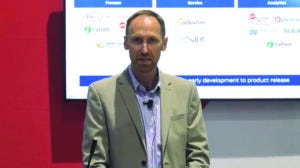- Sponsored Content
- Gene Therapies
Accelerating Industrialization of Genomic Medicine
August 24, 2022
Sponsored by Cytiva
 Clive Glover, general manager, gene therapy, Pall Corporation.
Clive Glover, general manager, gene therapy, Pall Corporation.
Glover observed that demand continues to grow for genomic medicines such as virally delivered gene therapies and RNA-based vaccines and treatments. With several such products approaching regulatory approval and many more in the clinical pipeline, manufacturing delays are inevitable. One strategy for reducing bottlenecks involves standardizing production processes for viral vectors and lipid nanoparticles (LNPs) that are used to deliver genomic therapies. Glover described the work of his company and other Danaher subsidiaries in establishing effective platforms.
Pall Corporation has developed platform processes for both adherent and suspension cell culture of adenoassociated virus (AAV). The adherent-cell process leverages the iCELLis 500 fixed-bed bioreactor system to generate 1016 viral genomes (vg)/mL reproducibly. Glover recalled that his company worked closely with AveXis (later Novartis) and Nationwide Children’s Hospital (Columbus, OH) to transition production of Zolgensma (onasemnogene abeparvovec) viral vectors from shake flasks to iCELLis 500 technology during clinical trials. Subsequent process development, which resulted in the approval and commercialization of Zolgensma product, established a foundation for a rapid and predictable AAV production platform. Meanwhile, Glover continued, process development efforts with Cevec Pharmaceuticals have generated a dependable platform for suspension cell culture of AAV vectors based on the Allegro STE bioreactor system. The process shows good productivity from scales of 10–200 L, and it holds much promise at 500-L and even 2,000-L volumes.
Downstream advances will be just as important as upstream developments to commercializing genomic medicines, Glover said. Removal of empty, partially filled, and incorrectly filled capsids from AAV material remains a focal point in the gene therapy industry. Pall Corporation leverages ion-exchange chromatography based on Mustang Q membrane adsorbers to enrich full-capsid populations.
Glover presented data showing that his company’s purification process can increase recovery of intact AAV particles to as much as 66%, which amounts to an enrichment of two- to six-fold. He added that membrane-based chromatography platforms have higher throughput than those based on resins. By enhancing processes based on Mustang Q adsorbers, Pall Corporation seeks to devise a standardized and truly end-to-end platform for AAV manufacturing.
Turning to RNA-based products, Glover explained that Pall has collaborated with sister company Cytiva to standardize a platform for mRNA manufacturing. The process spans from in vitro transcription through LNP encapsulation and fill–finish. Currently, the process yields 40–60 g/batch, which equals ~3 kg of mRNA per year.
Bolstering such efforts is recent Danaher acquisition Precision NanoSystems, which specializes in production of LNPs that contain self-amplifying mRNA (samRNA). Precision has developed a novel mRNA-LNP manufacturing platform and a comprehensive lipid library to help customers select delivery systems that target particular tissues. The platform, Glover explained, leverages a proprietary NxGen microfluidic mixing technology to control lipid formation. Data from studies of Precision’s NanoAssemblr Spark, Ignite, Blaze, and GMP LNP manufacturing instruments demonstrate that such control generates nanoparticles of uniform size, quality, and polydispersity across a wide range of scales. Glover added that Precision’s technologies enable users to develop effective scale-down models, which the biopharmaceutical industry needs if it hopes to increase the robustness of LNP production.
Currently, Precision is testing a platform for manufacturing samRNA vaccines. Glover presented data from studies in which a group of hamsters were inoculated with proprietary LNPs containing two samRNA molecules. The remaining subjects served as unvaccinated controls. All were challenged with SARS-CoV-2. The inoculated hamsters presented higher levels of neutralizing antibodies and lower viral loads than did their unvaccinated counterparts, indicating that the nanoparticles succeeded in delivering their payloads and that the samRNA molecules amplified in high enough quantities to stimulate immune responses.
Such results are highly promising, Glover explained. Using samRNA rather than standard nucleic acids could reduce vaccine dose requirements significantly, reducing manufacturing burdens in turn.
Fill out the form below to view the full BPI Theater presentation.
You May Also Like





